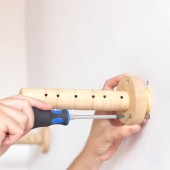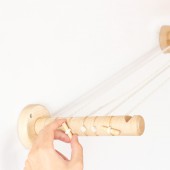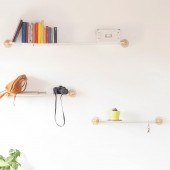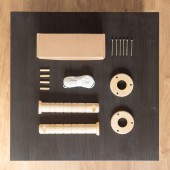
| THE AWARD |
| CATEGORIES |
| REGISTRATION |
| SUBMIT YOUR WORK |
| ENTRY INSTRUCTIONS |
| TERMS & CONDITIONS |
| PUBLICATIONS |
| DATES & FEES |
| METHODOLOGY |
| CONTACT |
| WINNERS |
| PRESS ROOM |
| GET INVOLVED |
| DESIGN PRIZE |
| DESIGN STORE |
| THE AWARD | JURY | CATEGORIES | REGISTRATION | PRESS | WINNERS | PUBLICATIONS | ENTRY INSTRUCTIONS |
Xanxan Shelf by Carles Marquina |
Home > Winners > Design #57563 >Interview |
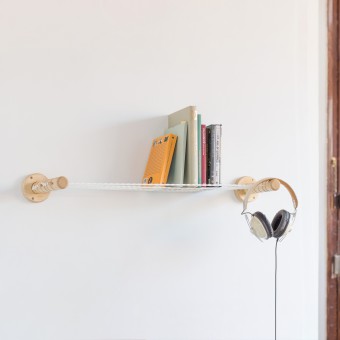 |
|
FS: What is the main principle, idea and inspiration behind your design?
CM: The most direct principle has been material reduction. We know that it is vital for the planet and that, commercially, is very advantageous, we see it constantly in examples like Ikea. As an inspiration, we are obliged to mention (although It was not consciously or explicitly in the design process) the clothes rack that is very common in the Mediterranean lands.
FS: What has been your main focus in designing this work? Especially what did you want to achieve?
CM: Xanxan was first conceived under the challenge of reducing the material cost and ecological impact of an existing concept. We were specifically looking for an unexploited product category in which we could contribute with fresh ideas.
FS: What are your future plans for this award winning design?
CM: This product is currently available on a small scale basis. We are looking for companies interested in producing an industrial scale to ultimately reduce its costs.
FS: How long did it take you to design this particular concept?
CM: We started the project in the Polytechnical University of Valencia, where its first 5 months of development took part, reaching the concept stage. After finishing our degrees and creating the studio, the design process was summarized and finished after 7 more months of work.
FS: Why did you design this particular concept? Was this design commissioned or did you decide to pursuit an inspiration?
CM: This design was born from a personal project. We are convinced that the formal reduction of a concept without sacrificing its functionality is one of the reasons for design. And as we are convinced that this product achieves this goal, we were quite clear that we should make it a reality to exemplify the values we want to convey through Smallgran.
FS: Is your design being produced or used by another company, or do you plan to sell or lease the production rights or do you intent to produce your work yourself?
CM: We are looking for companies interested in producing and distributing this product. Our priority right now is to find a company with which to produce it on an industrial scale. That was our intention in designing it. However, if we observe sufficient demand and we do not find producers, we are planning to produce it ourselves.
FS: What made you design this particular type of work?
CM: We detected a market opportunity and found a solution that allowed us to improve an existing concept in a new and impressive way. As a young studio, it was the ideal design to capture the attention of the design world and to win awards.
FS: Where there any other designs and/or designers that helped the influence the design of your work?
CM: Sure, everything influences everything. But at a conscious level during the design process we did not have any so I could not tell you specific names.
FS: Who is the target customer for his design?
CM: People curious, playful and different, who is not afraid to do things differently.
FS: What sets this design apart from other similar or resembling concepts?
CM: Obviously, right? Compare it with a normal shelf, it has nothing to do. That was one of our goals. Since if we had designed something that looked too much like a normal shelf, we would not have been able to differentiate it so much that people would pay attention to it.
FS: How did you come up with the name for this design? What does it mean?
CM: It's pretty silly, just like us. Xanxan is what sounds in movies in moments of tension (at least in Spanish), and tension is the protagonist in this design.
FS: Which design tools did you use when you were working on this project?
CM: This project involved some old-fashioned methods. Most consisted of experimentation and prototyping, so we used many workshop tools to create and test the different systems we were weighing.
FS: What is the most unique aspect of your design?
CM: It must be the tension. It is an element that is not usually present in furniture products and here, we not only introduce it, but we give it a leading role.
FS: Who did you collaborate with for this design? Did you work with people with technical / specialized skills?
CM: In the detail design phase we work with workshop technicians and artisan carpenters from our land to optimize materials and form.
FS: What is the role of technology in this particular design?
CM: It is a rather important role, even if it does not seem so. The technology we use for string tensioning is extremely simple, which is not easy to achieve, and we had a hard time developing it (although just because of its simplicity I would not dare to say that we discovered it or that it is exclusive of this design).
FS: Is your design influenced by data or analytical research in any way? What kind of research did you conduct for making this design?
CM: This project was driven mainly by market research and experimentation. Starting from the goal of reducing the material cost and ecological impact of an existing concept we started to study companies as big as Ikea in order to understand their approach and to find an unexploited product category in which we could contribute with fresh ideas. We have decided that we should be able to develop our initial goal while delivering an interesting and new design proposal. From that point on, it was mainly creativity and experimentation but always with the goal of meeting the requirements for shelves, fixed by the best-selling shelves in the market to ensure our product's viability.
FS: What are some of the challenges you faced during the design/realization of your concept?
CM: The main design challenge we encountered was to develop a solution that would feel new and creative while fulfilling the initial goal of reducing the material cost and ecological impact of an existing product concept. From the technical perspective, this product posed three main challenges: 1. Developing a tensioning mechanism for the strings. It had to fix the strings, allowing for progressive tensioning without the need to disassemble the product and we needed to keep it simple in order to maintain the cost low. 2. Finding a wood that is light-weight and cheap but at the same time resistant and resistant enough to withstand the tension of the strands. 3. Finding a rope that holds its mechanical and dimensional properties over time, and is cheap, lightweight and feels good.
FS: How did you decide to submit your design to an international design competition?
CM: After getting some press, we were contacted by the Design Award staff and they told us they wanted us in the competition. It was the first time we got an invitation like that and we were pretty thrilled, plus the prize was aligned with our views of this product's future (getting a company to produce it) so we accepted.
FS: What did you learn or how did you improve yourself during the designing of this work?
CM: We already knew designing things to be simple was very difficult, but we had never done it. It turned out to be extremely difficult, but we love a good challenge.
FS: Any other things you would like to cover that have not been covered in these questions?
CM: Check the other interviews!
FS: Thank you for providing us with this opportunity to interview you.
A' Design Award and Competitions grants rights to press members and bloggers to use parts of this interview. This interview is provided as it is; DesignPRWire and A' Design Award and Competitions cannot be held responsible for the answers given by participating designers.
| SOCIAL |
| + Add to Likes / Favorites | Send to My Email | Comment | View Press-Release |

